The unsettled future of Tompkins EMS Cost-Sharing
Reporting and analysis by Robert Lynch, April 5, 2024
Those among us old enough can recall how military hawks in the 1960’s employed the “Domino Theory” to justify the Vietnam War. If you don’t stop communists there, they argued, Chairman Mao would soon be landing his troops on the coast of California.
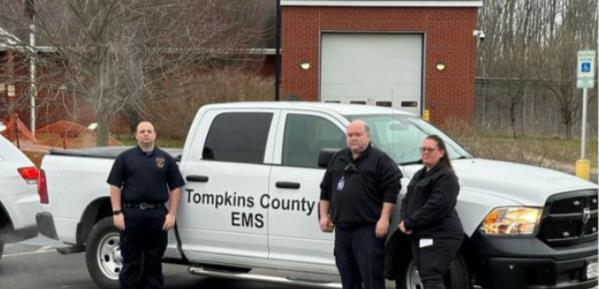
Of course, that never happened. And we all know how the Vietnam War turned out. But some could argue that the same fear about tumbling dominoes is playing out in real time this month in the chambers of the Tompkins County Legislature. And those who worry may be advancing scenarios equally as flawed.
On Tuesday, April second, Tompkins County launched its Rapid Medical Response (RMR) service. The program’s modest start-up employs three, white SUV’s and pickups, cast-offs from the Tompkins County motor pool. County Government hired a handful of Emergency Medical Technicians (EMT’s) to drive them. Strategically placed about the county, the RMR EMS units answer medical emergency calls during daytimes and on weekdays only. They do so—at least in theory—only when a rural volunteer rescue squad cannot respond itself.
No one opposes the service. The only question involves who will pay for it. A surprisingly generous state grant has covered this year’s initial cost. It’s the two-year pilot program’s second-year funding that’s divided opinions among legislators and municipal leaders.
“I think that the municipalities need to have a dog in this fight,” Dryden representative Mike Lane told his colleagues on the Tompkins County Legislature Tuesday night. “They need to be working partners with it,” Lane asserted. “I don’t think that the County should just automatically take this on.”
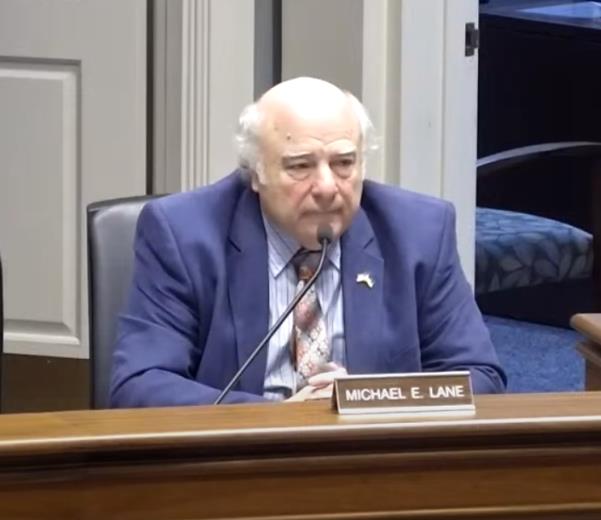
Lane’s comment fell five days after town and village board members, convened as the Tompkins County Council of Governments (TCCOG) March 28th, voted unanimously to endorse full Tompkins County funding of the program’s second year, a $510,000 expense. Rordan Hart, Mayor of Trumansburg, has become the driving force behind letting Tompkins County pay the full cost. Anne Koreman, Trumansburg’s (and northern Enfield’s) representative, has become Hart’s most vocal advocate within the Legislature.
“This is a service that encompasses all municipalities, and I don’t see how we can parse it up,” Koreman told the Legislature at its meeting.
The Enfield Town Board—at this Councilperson’s urging—unanimously endorsed Mayor Hart’s position by passing its own Resolution of support March 13th.
Yet a small, albeit persistent cadre of legislators, one that includes Dryden’s Lane and also the City of Ithaca’s Rich John, have for months sought municipal contribution to the RMR. They’ve floated various options. The currently-favored plan would have Tompkins County underwrite two-thirds of the 2025 expenses ($351,000), and have ten local municipalities divvy up the remaining burden. The cost-sharing model advanced at a meeting in late-February would draw $10,000 from next year’s Enfield Town budget.
But the argument is more than just about money. Tompkins County has plenty of cash. It’s about underlying fears of those elusive tumbling dominoes that drive key legislators to demand the towns contribute at least something toward the RMR service.
Most importantly, it’s a worry that when County Government steps in to help, town rescue squads will conveniently and predictably step back; they’ll withdraw from the effort and shirk their traditional, time-honored responsibilities. Arguably, it’s a worry nowhere founded in fact. But for Groton’s Lee Shurtleff Tuesday night, doomsday scenarios pervaded his remarks. They extended beyond a fire company’s EMT assignments to the ranks of firefighters themselves.
“Have we set a precedent that we’re going to step forward?” an animated Shurtleff asked fellow legislators that night. Could 12-hour–a-day EMT service, he said, grow to 24?
Shurtleff reached farther. “The next step is also going to be in the fire service, who has traditionally provided that first response. The fire service is unable to provide levels of support beyond basic fire services…. We’re going to see fire departments begin to shut down. Is the county going to be expected to step into that role?”

“We need to be looking ahead and not be expected to take on these things without some corresponding commitment and corresponding level of support from those who have traditionally raised the taxes to provide these services,” the wound-up Groton legislator, former Director of Tompkins County’s Department of Emergency Response, continued. “I could care less in many ways about how much the towns contribute back. What I care about is that there be an acknowledgement that these have traditionally been their services and that we’re going to work together to continue to provide these services.”
Lee Shurtleff’s Parade of Horribles about fire departments shutting down may not find a welcome reception in Enfield. Our taxpayers just invested more than $1 Million in principal and interest to buy a new fire truck. And our fire station stands nowhere near locking its doors. True, our EVFC always needs more volunteers. But what’s on the table now is merely how to pay for a trio of wannabe-flycars and the people who drive them, EMT’s at-the-ready sometimes and other times not.
Whoever hurt his or her hip at 9:20 AM, Tuesday, April second, made himself or herself an anonymous celebrity. That person became the first patient served by Tompkins County’s Rapid Medical Response system. Its EMT arrived at the scene seven minutes after the call came in. The transport ambulance, simultaneously dispatched, took a full 22 minutes.
“The take-away from this first call was that without this service, this person would have been alone on the ground in their house with a hip injury for 22 minutes until the transport unit arrived,” County Administrator Lisa Holmes informed the Tompkins County Legislature in her report that night. “So out of the gate, or at least with this example, it appears that the program is doing what it’s designed to do.”
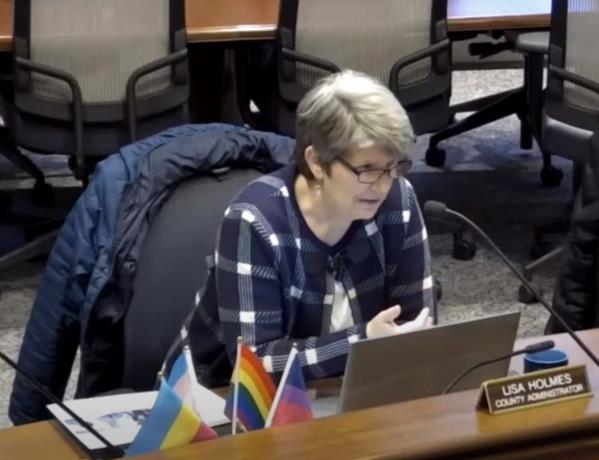
Moments after Holmes said those words, the Enfield Board of Fire Commissioners convened its own meeting at the Enfield Fire Station. And at that session, leaders made it clear that aside from the new help gladly appreciated from Tompkins County, nothing has really changed.
“This program doesn’t mean our rescue squad is out of business,” Enfield Volunteer Fire Company President Dennis Hubbell told Fire Commissioners. “We will communicate that to members Thursday (training night),” Hubbell stressed.
Commissioners Chair Greg Stevenson agreed. “This does not supplant anything that’s in place.”
Tuesday morning’s inaugural call—the hip injury—was an “Alpha” call, second-to-the-bottom on a six-tiered hierarchy of medical emergencies. Enfield’s rescue squad doesn’t even answer “Alpha” calls. Few others in Tompkins County do either. So what Administrator Holmes talked about that night never idled a single community volunteer. Rather, it provided a heightened level of care. It didn’t relax any municipal burden.
In fact, Enfield Fire Chief Jamie Stevens recognized that by answering low-level, Alpha-type calls, the RMR could stretch itself thin. That white SUV could be attending a broken leg in southern Newfield while a more serious incident simultaneously calls out the Enfield rescue squad closer to home.
Stevenson told Chief Stevens that while he welcomes the new service, he also recognizes its limitations.
Tompkins County municipal leaders and Administrator Holmes will reconvene April 11th to discuss cost-sharing further.
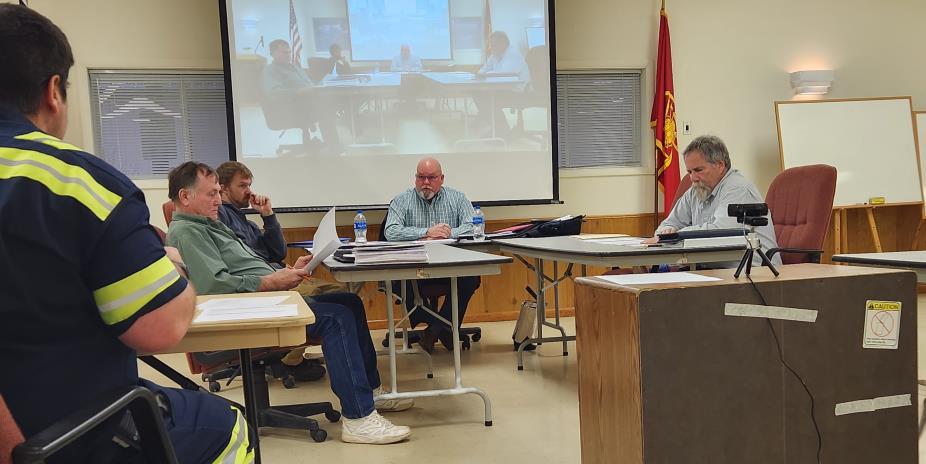
“I prefer we don’t have another meeting,” legislator Koreman said, sensing no need to discuss cost-sharing any further. Nonetheless, the mid-April session will still be held. Koreman has argued that Tompkins County should regard the RMR service like the Sheriff’s Office; there for all regardless of need, regardless of a municipality’s ability to pay.
“I really do think the example of the Sheriff’s Office and how we fund that is really spot-on,” Caroline Supervisor Mark Witmer told TCCOG March 28th. Witmer spoke before TCCOG’s members unanimously adopted Mayor Rordan Hart’s resolution to back total County funding of the Rapid Medical Response service. “I think trying to designate how each community will benefit or differ—in the end, it will hurt us; it will create a vulnerability in the program.”
This Enfield Councilperson, Robert Lynch, agreed: “If somebody backs out, and another one backs out, and a third one backs out, that’s going to lead to a lot of animosity and rivalry among the municipalities that remain.” This writer reported hesitancy by City of Ithaca representatives at County Administration’s late-February meeting to participate fully in cost-sharing or to recognize participation’s benefits.
Under the cost-sharing model advanced at that February meeting, the City would pay-in more than any other municipality, $32,000, or one-fifth of the predicted $159,000 combined municipal share.
County legislators have credited their Chairman, Dan Klein, for authoring the compromise cost-sharing model now under review. Because it seeks City participation, it would cost rural towns less than had previous formulas. In municipalities having their own paid ambulance services—including Ithaca—the plan would assess local governments at one dollar per resident. Non-ambulance towns, like Enfield, would pay $3.00 per head.
Conceding TCCOG was headed toward endorsing Mayor Hart’s proposal that day, Klein futilely defended his alternative. “The cost-sharing was going to distribute the costs a little more equitably among the people who aren’t already paying as much for emergency medical services,” Klein said.
“Your budgets are going to look a little better; Tompkins County’s budget is going to look a little worse,” the Legislature’s chair conceded, should County Government pay the full expense. But if that happens, he cautioned municipal leaders, “You, the towns, are hiding some of the costs from your constituents.”
Klein cited Ulysses as an example. Ulysses already contracts with Trumansburg Ambulance for emergency coverage. Its rejection of cost-sharing, Klein predicted, could impose a $2.00 per person burden on each of its taxpayers. Ulysses Supervisor Katelin Olson held a ready answer.
“I will tell property owners when they learn about this, if they do have concerns about paying more than their fair share, I will say that our ambulance system that we pay into with the Village of Trumansburg will be healthier because our neighbors are going to be healthier.” Olson specifically cited potential beneficiaries in Enfield.
“We often talk about in storm water that water doesn’t respect municipal boundaries. Well, in the EMS world, health emergencies don’t respect municipal boundaries as well,” Olson said. And embracing the Sheriff’s Department analogy, she added, “We all benefit by having healthy law enforcement. We will all benefit by having healthier EMS services.”
Trumansburg’s Mayor Hart, whose Resolution won TCCOG unanimous municipal support that day, commended Dan Klein’s cost-sharing comprise as “quite elegant,” qualifying his words, “as cost-sharing models go.” But the mayor stressed he’s looking beyond the immediate. “I’m really trying to look at this from the perspective of how do we bullet-proof this program for the long-term,” Hart told TCCOG.
Emergency response, Hart argued, is today an “intertwined network” and “not a local rescue matter.” And, he added, “Having the County fully fund it as a County program does better than any type of attempt to share the cost.”
To an extent, Rordan Hart and Lee Shurtleff are moving toward the same destination. They’d just each reach it by a different path. Hart would place this newly-evolving 21st Century rescue service, intertwined as it is, under Tompkins County’s full fiscal umbrella. Lee Shurtleff would keep base funding where it’s traditionally been, mostly within individual town fire service budgets.
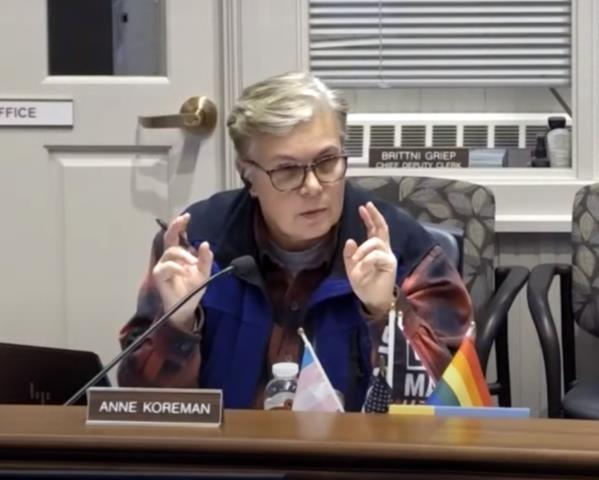
“This conversation is important,” Shurtleff told those at the Legislature, “and it can’t just stop with one vote by one group that thinks the County should take it on 100 per cent,” a not-so-veiled reference to TCCOG’s recommendation.
“As far as a dog in the fight,” Shurtleff said, recalling colleague Mike Lane’s earlier remark, “all the dogs in the fight up until today were theirs, were the towns’ were the villages’, were the fire districts.”
To Shurtleff, dominoes may stand teetering, poised to fall, with burdens readying to shift in multiple ways from our town governments to those downtown.
A couple chairs down the table, Anne Koreman thought differently that night. The Ulysses representative expressed little concern about newly-shouldered long-term commitments or the setting of dangerous precedents. Instead, she kept it simple. Koreman narrowed the focus to just those three little white vehicles plying the roads of Tompkins County to attend to dislocated hips and whatever else may prompt a 911 call.
Of volunteer rescue ranks, Koreman said, “They’re really scared out there, to not be able to get to people in time. So this helps them, they said, to be able to sleep at night, to know that the County kind of—what they said to me—we have their back.”
###

